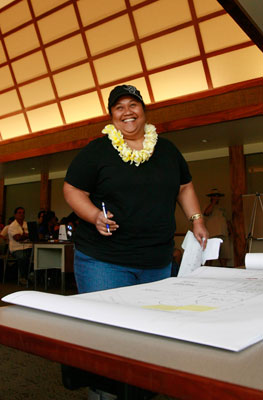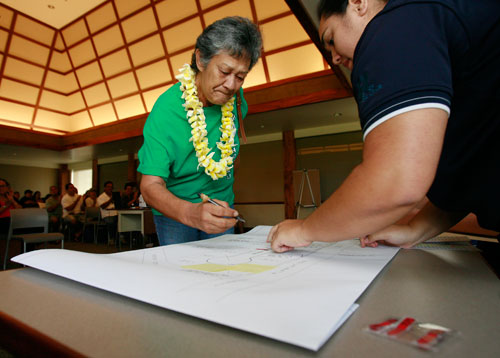Housing project is a green model

Uilani Keliikoa selected her lot in the new Kaupuni subdivision yesterday at the Department of Hawaiian Home Lands in Kapolei

The state Department of Hawaiian Home Lands awarded homes in the Kaupuni subdivision in Waianae to 19 native Hawaiian families yesterday. Lizzie Evangelista, left, who was the first of the applicants to select the lot of her future home, was on the DHHL waiting list since 1977. Assisting her was DHHL homestead housing specialist Solana Rosa-Tutop.


The state Department of Hawaiian Home Lands awarded homes to 19 native Hawaiian families yesterday in a pilot affordable housing development in Waianae that meshes Hawaiian cultural practices with cutting-edge environmental design.
Although the 3-acre Kaupuni subdivision is the smallest DHHL project in the past seven years, it could have major ramifications on future Hawaiian Home Lands developments.
DHHL said it hopes Kaupuni’s focus on community-building and environmental sustainability will serve as a model for much larger projects, including a planned 400-unit subdivision in Makaha Valley.
"I look at it as a way to champion our project," said department Chairman Kaulana Park. "We know it will work. The people will make it work."
Under Kaupuni’s new community-centered model — what DHHL calls a modern ahupuaa — residents will be required to maintain a neighborhood garden and hula studio to teach Hawaiian culture, language and arts. A new community center will also provide a space for neighborhood meetings and educational programs on financial literacy, economic development and higher education.
"You’re going to start to see how our community is going to come together," Park said. "It’s about the aloha spirit … about starting someplace first and allowing that spirit to grow."
Don't miss out on what's happening!
Stay in touch with breaking news, as it happens, conveniently in your email inbox. It's FREE!
The subdivision is expected to be the nation’s first affordable housing development awarded LEED Platinum certification — the highest distinction given by the U.S. Green Building Council for leadership in energy and environmental design. The entire community has also been given a net-zero energy designation, meaning it will produce all the energy it consumes.
All homes will be outfitted with photovoltaic panels, solar water heaters, electric vehicle outlets and energy-efficient appliances. The single-family houses will also feature energy monitoring systems to allow residents to constantly track their energy usage.
According to DHHL spokesman Kamana’o Mills, this is the first time that such green technology has been applied to an entire affordable housing community. Although the federal Department of Energy has invested heavily in net-zero housing programs, much of the pricey technology remains out of reach for families with lower incomes.
"It’s not just about building LEED Platinum homes," Mills said. "It’s about building them affordably."
ALL FAMILIES chosen to live in the development make less than 80 percent of the state median household income set down by the federal Department of Housing and Urban Development.
In order to be considered, homeowners must be at least half native Hawaiian and must be on the Hawaiian Home Lands waiting list. Many of the families awarded homes in the Kaupuni subdivision have been on the list for more than a decade.
Before awarding the homes, DHHL also screened the 19 families to ensure that they could make mortgage payments on their new homes, which cost between $200,000 and $250,000.
Each lot is 5,000 square feet with either a three- or four-bedroom house. The state broke ground on the Kaupuni community center and the 19 homes in March and expects the families to move in by December.
The state will lease land to the families for 99 years at $1 per year, with an option for a 100-year extension.
The project was funded by DHHL and a part of a $10.2 million grant given through the American Recovery and Reinvestment Act. According to Park, the federal stimulus money allowed DHHL to lower home price tags by more than $50,000 for each family.
Although Kaupuni was not funded out of the state’s general fund, the housing project received political support from Lt. Gov. Aiona. Speaking at yesterday’s lot-selection meeting, Aiona said the community will serve as a global model for sustainability.
"This is the model for not only Hawaii, but the nation and the world," Aiona said. "What’s so exciting is Hawaiians are leading the way."
A number of the Kaupuni homeowners received support through other DHHL programs before qualifying for the homes.
Less than a decade ago, Lizzie Evangelista — the first homeowner selected yesterday — was living homeless in Waianae’s Maili Beach Park when she found shelter and financial counseling through DHHL.
Evangelista, who will be sharing her home with her daughter’s family, was on the DHHL waiting list since 1977 but was not financially eligible for a home until now.
"I waited a long time — about 40 years," Evangelista said. "I think something like this is really great. I love it."



